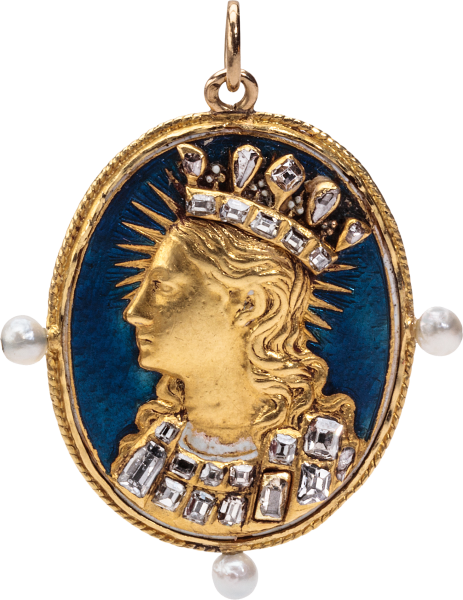


Cameo with Double Portrait of Cosimo I de Medici and Camilla Martelli
, Cameo, Northern Italy, late 16th century; mount with pin 18th century and later

Cameo with Double Portrait of Cosimo I de Medici and Camilla Martelli
Description
Two-layered onyx cameo (white on translucent pale brown) with jugate heads facing to the right looking upwards. The male head with short curly hair, beard and moustache wears a tunic draped around his neck and shoulders. The female head in the background has her hair tied back. They are cut in the white layer of the stone with translucent pale brown background. The cameo is convex on the reverse and open-set in a pendant with plain gold collet and rounded edges. A long gold pin is attached to the pendant loop and the opposite end has a section of coiled wire
Literature:
Portraits of Roman Emperors were popular and highly fashionable during the Renaissance period, rulers would often be portrayed like their ancient counterparts, also as a double portrait with spouse, or known as jugate heads. The individual features of the couple portrayed here suggest it could be a double portrait of Cosimo I de Medici (1519-1574) at a slightly older age and his second wife Camilla Martelli, Duchess Consort of Florence (1545-1590) whom he married in 1570. Bust sculptures of Cosimo de Medici in the Galleria Uffizi by Baccio Bandinelli from 1554-8 (1911, no. 671) and Giovanni di Benedetto Bandini in the Los Angeles County Museum (M. 81.39) show him with full beard and moustache. Cf. also a porphyry relief by Francesco di Giovanni Ferucci with Cosimo’s effigy on serpentine in the Victoria and Albert Museum, London (1-1864) from 1570.
Cosimo was famed for using his portrait images for political gain, cf. Kurt W. Forster. “Metaphors of Rule. Political Ideology and History in the Portraits of Cosimo I de’ Medici,” Mitteilungen des Kunsthistorischen Institutes in Florenz, 15, no. 2 (1971): 65-104.
A well-known large cameo of Cosimo I de Medici in the Museo degli Argenti, the Treasury of the Grand Dukes in the Pitti Palace in Florence, shows him at a younger age with his first wife Eleonor of Toledo (1519-62) and their children. It is made by the Milanese carver Giovanni Antonio de’ Rossi before moving to Rome in 1562 (Riccardo Gennaioli. Le gemme dei Medici al Museo degli Argenti. Cammei e Intagli, Guinti Editore 2007, pp. 106-8). The identification of Camilla Martelli is more complicated as her portrait painted by Alessandro Allori in the Dallas Museum of Art (1987.11) had previously been attributed to Bianca Capello.
During the sixteenth and seventeenth century Northern Italy was renowned for the high craftmanship of gem-cutters, where this cameo was probably carved, whilst the pendant probably dates to the eighteenth century with a later pin attached.
